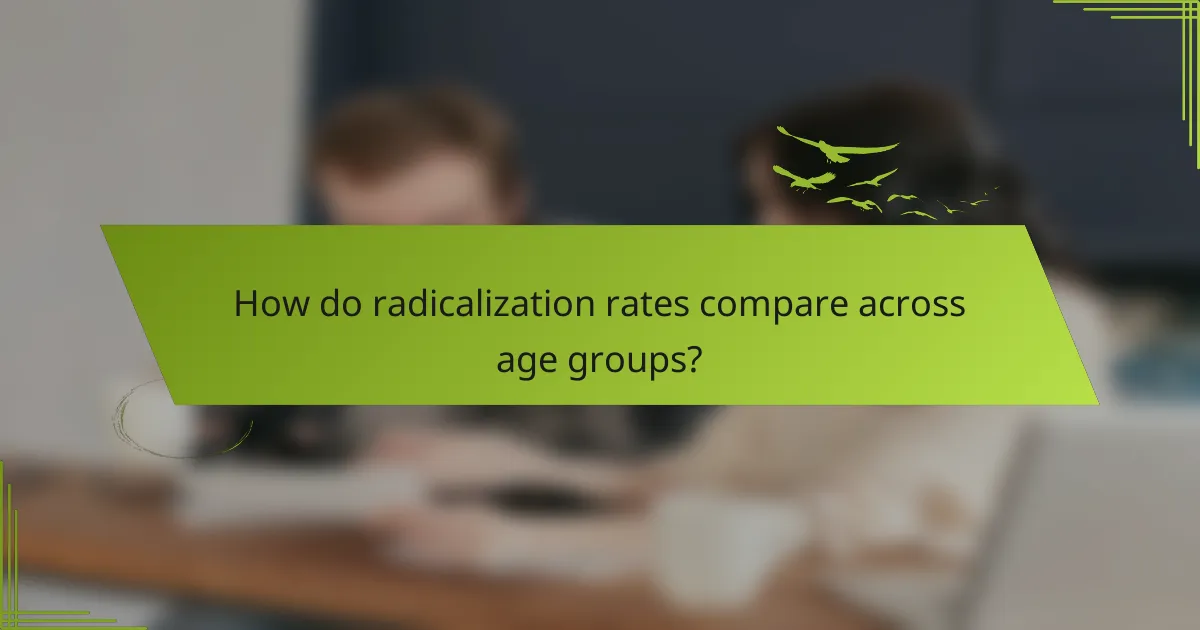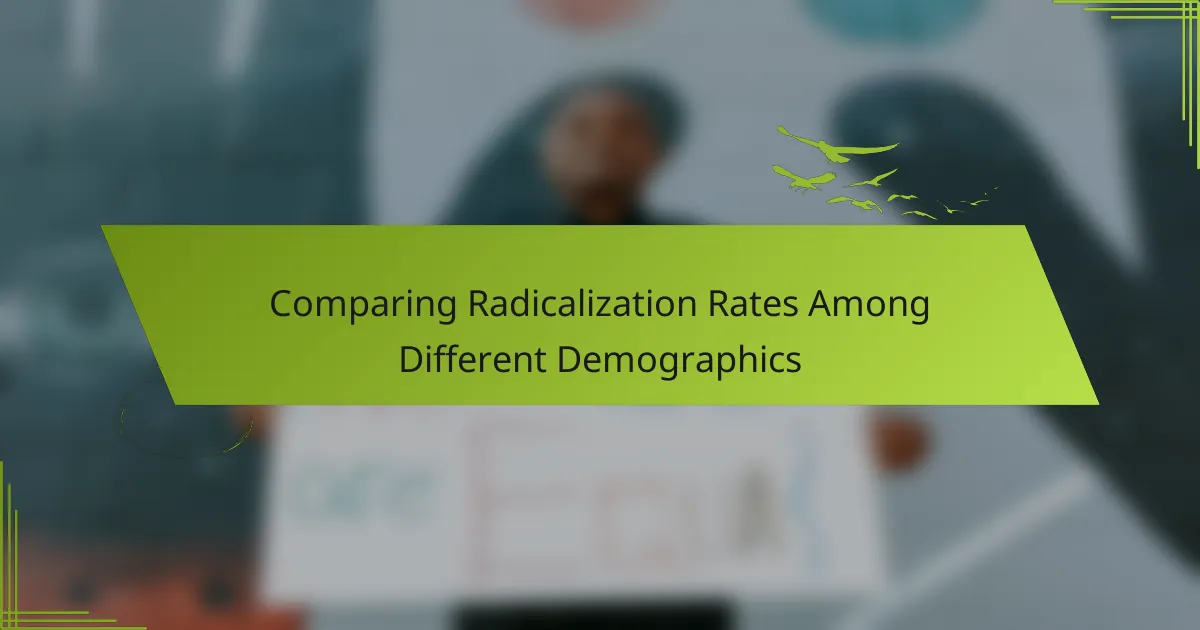Radicalization rates in the United States are influenced by various demographic factors, including age, location, and socioeconomic status. Younger individuals, particularly in urban areas, tend to exhibit higher rates of radicalization, while those from lower income and education backgrounds face increased risks due to social isolation and limited opportunities. Understanding these dynamics is crucial for addressing the root causes of radicalization across different groups.

What are the radicalization rates among different demographics in the United States?
Radicalization rates in the United States vary significantly among different demographics, influenced by factors such as age, location, and social environment. Generally, younger individuals, particularly in urban settings, show higher rates of radicalization compared to those in rural areas.
Higher rates in urban youth
Urban youth are often more susceptible to radicalization due to factors like social isolation, exposure to diverse ideologies, and higher rates of socioeconomic challenges. In cities, the presence of extremist groups can also create environments where radical ideas gain traction among impressionable young people.
For instance, studies indicate that urban youth may experience radicalization rates that are several times higher than their rural counterparts. This can be attributed to the availability of online platforms and community networks that facilitate the spread of extremist narratives.
Lower rates in rural populations
In contrast, rural populations tend to exhibit lower rates of radicalization, often due to tighter-knit communities and less exposure to extremist ideologies. The social fabric in rural areas can provide a buffer against radical influences, as community ties often promote shared values and discourage divisive beliefs.
However, this does not mean rural areas are immune to radicalization. Factors such as economic decline or political disenfranchisement can still lead to increased susceptibility among certain groups within these populations. Awareness and proactive community engagement are essential to mitigate these risks.

How do radicalization rates compare across age groups?
Radicalization rates vary significantly among different age groups, with younger individuals often exhibiting higher susceptibility. This trend highlights the importance of understanding the factors that contribute to radicalization within these demographics.
Increased rates among young adults
Young adults, particularly those in their late teens to early twenties, tend to show increased rates of radicalization. This demographic is often more impressionable and may be influenced by social media, peer pressure, and a search for identity. Factors such as unemployment and lack of social support can further exacerbate their vulnerability.
For instance, studies indicate that young adults may be drawn to extremist ideologies as a means of belonging or purpose. Engaging with online communities can facilitate this process, making it crucial for interventions to target these platforms effectively.
Decreased rates in older demographics
In contrast, older demographics generally exhibit decreased rates of radicalization. Individuals in their thirties and beyond often have more established social networks, careers, and responsibilities, which can act as stabilizing factors. This maturity may lead to a more critical perspective on extremist ideologies.
Moreover, older individuals may have different motivations and life experiences that make them less susceptible to radicalization. Understanding these differences is essential for developing targeted prevention strategies that address the unique needs of various age groups.

What role does socioeconomic status play in radicalization?
Socioeconomic status significantly influences radicalization rates, with lower income and education levels often correlating with higher risks. Factors such as lack of access to resources, social isolation, and limited opportunities can create environments conducive to extremist ideologies.
Higher risk in low-income communities
Low-income communities frequently face systemic challenges that can lead to feelings of disenfranchisement and vulnerability. Limited economic opportunities, inadequate education, and high unemployment rates may foster resentment and a search for identity, making individuals more susceptible to radicalization.
Moreover, social networks in these areas can sometimes reinforce extremist views, as individuals may seek belonging or support within groups that promote radical ideologies. This creates a feedback loop where isolation and economic hardship contribute to increased radicalization risks.
Lower risk in affluent neighborhoods
Affluent neighborhoods typically exhibit lower radicalization rates due to greater access to education, economic stability, and social resources. Residents in these areas often have more opportunities for engagement in civic activities and community support, which can mitigate feelings of alienation.
Additionally, the presence of diverse social networks in wealthier communities can promote tolerance and understanding, reducing the appeal of extremist ideologies. However, it is essential to recognize that radicalization can still occur in affluent settings, albeit at a lower frequency compared to low-income areas.

How does education level impact radicalization rates?
Education level significantly influences radicalization rates, with lower educational attainment often correlating with higher susceptibility to extremist ideologies. Individuals with limited education may lack critical thinking skills and access to diverse perspectives, making them more vulnerable to radicalization.
Higher rates among less educated individuals
Research indicates that individuals with lower education levels are more likely to engage in radicalization. This demographic often faces socioeconomic challenges, which can foster feelings of disenfranchisement and frustration, making extremist narratives more appealing.
For example, those who have not completed secondary education may struggle to find stable employment, leading to increased susceptibility to groups that promise purpose and belonging. The lack of educational resources can also limit exposure to counter-narratives that challenge extremist views.
Lower rates in college-educated populations
In contrast, college-educated individuals generally exhibit lower radicalization rates. Higher education often promotes critical thinking, exposure to diverse viewpoints, and a greater understanding of complex social issues, which can mitigate extremist influences.
College environments typically encourage dialogue and debate, allowing students to confront and question radical ideologies. This exposure can foster resilience against extremist recruitment, as educated individuals are more likely to engage with differing perspectives and develop a nuanced understanding of global issues.

What are the psychological factors influencing radicalization?
Psychological factors influencing radicalization include identity crises, social isolation, and the need for belonging. These elements can drive individuals to adopt extremist beliefs as a means of coping with personal or social challenges.
Impact of identity crises
Identity crises often occur during significant life transitions, such as adolescence or migration, leading individuals to question their beliefs and values. This uncertainty can make them more susceptible to radical ideologies that offer a clear sense of identity and purpose.
For example, young adults facing cultural dislocation may gravitate toward extremist groups that promise a strong community and a defined identity. Understanding these crises can help in developing interventions that provide alternative support systems.
Role of social isolation
Social isolation can significantly contribute to radicalization by creating an environment where individuals feel disconnected from mainstream society. This detachment often leads to a search for belonging, making extremist groups appealing as they provide a sense of community and acceptance.
Individuals who experience loneliness or lack social support are at a higher risk of being drawn into radical movements. Addressing social isolation through community engagement and support networks can be crucial in preventing radicalization.

How do online platforms contribute to radicalization?
Online platforms significantly contribute to radicalization by facilitating the spread of extremist ideologies and enabling users to connect with like-minded individuals. These platforms often amplify radical content through algorithms that prioritize engagement over safety, leading to increased exposure to harmful narratives.
Influence of social media algorithms
Social media algorithms are designed to maximize user engagement, often promoting content that elicits strong emotional reactions. This can result in users being exposed to radical viewpoints more frequently, as sensational or controversial posts are prioritized. For instance, users who interact with extremist content may find their feeds increasingly populated with similar material, creating echo chambers.
To mitigate this effect, users should be mindful of their engagement patterns and actively seek diverse perspectives. Limiting interactions with extremist content can help reduce algorithmic reinforcement of radical ideas.
Role of extremist online communities
Extremist online communities provide a space for individuals to share and reinforce radical beliefs. These groups often employ tactics such as normalization of violence and groupthink, making it easier for members to adopt extremist views. Participation in these communities can lead to a sense of belonging, which further entices individuals to embrace radical ideologies.
To counteract the influence of these communities, it is crucial for individuals to engage with a variety of viewpoints and seek out constructive discussions. Awareness of the tactics used by extremist groups can help users recognize and avoid falling into radicalization traps.

What preventive measures are effective against radicalization?
Effective preventive measures against radicalization include community engagement programs and educational outreach initiatives. These strategies aim to foster understanding, build resilience, and create supportive environments that deter extremist ideologies.
Community engagement programs
Community engagement programs focus on building trust and collaboration between local authorities and community members. They often involve activities such as workshops, dialogues, and cultural events that promote inclusivity and understanding among diverse groups.
These programs can be tailored to specific demographics, addressing unique concerns and fostering a sense of belonging. Successful initiatives often include partnerships with local organizations and leaders to ensure relevance and effectiveness.
Educational outreach initiatives
Educational outreach initiatives aim to inform and empower individuals, particularly youth, about the dangers of radicalization. These programs typically include workshops, seminars, and online resources that provide critical thinking skills and promote media literacy.
By equipping participants with the tools to analyze information critically, these initiatives help reduce susceptibility to extremist narratives. Schools and community centers can play a vital role in implementing these educational strategies, ensuring they reach a broad audience.

How do radicalization rates differ among ethnic groups?
Radicalization rates can vary significantly among different ethnic groups, often influenced by social, economic, and political factors. Minority communities tend to experience higher rates of radicalization compared to majority populations, which can be attributed to feelings of marginalization and disenfranchisement.
Higher rates in minority communities
Minority communities often face systemic challenges such as discrimination, economic inequality, and social exclusion, which can contribute to higher radicalization rates. These factors may lead individuals to seek belonging and identity within extremist groups that promise empowerment and purpose.
For example, studies have shown that young people in marginalized ethnic groups may be more susceptible to radical ideologies when they perceive a lack of opportunities or representation in mainstream society. This sense of alienation can create fertile ground for extremist narratives to take root.
Lower rates in majority populations
Majority populations generally exhibit lower radicalization rates, largely due to greater access to resources and social integration. Individuals in these groups often benefit from established societal structures that provide stability and opportunities, reducing the appeal of extremist ideologies.
Additionally, majority communities may have more robust support systems and social networks that counteract radical influences. As a result, the likelihood of individuals from these populations turning to radicalization is significantly diminished compared to their minority counterparts.
